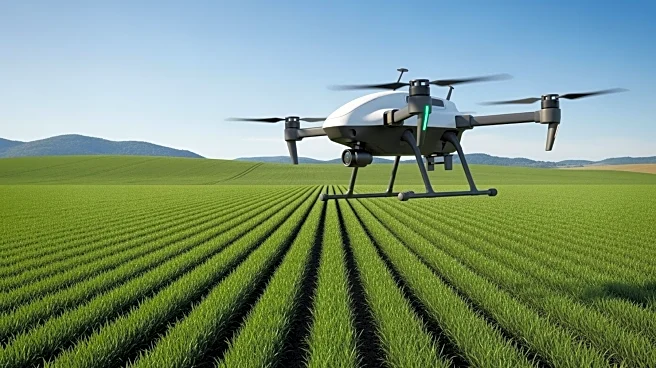What's Happening?
The agriculture drones market is expected to grow significantly, with projections indicating it will reach $10.76 billion by 2030. This growth is driven by increasing awareness among farmers about the
benefits of drones in enhancing productivity, resource efficiency, and sustainable farming practices. Drones offer real-time aerial data for crop monitoring, soil analysis, and precision spraying, which reduces waste and increases yield. The versatility of agriculture drones allows them to be used for seeding, spraying, mapping, and yield forecasting, maintaining accuracy and cost-effectiveness. Advances in automation, imaging, and battery technology support the popularity of fixed-wing, rotary, and hybrid drones. The market is further bolstered by supportive government policies, rising labor challenges, and a growing ecosystem of Agri-tech startups.
Why It's Important?
The expansion of the agriculture drones market is significant for the U.S. agricultural sector as it promises to revolutionize traditional farming practices. By providing precise and efficient farming solutions, drones can help farmers optimize resource usage and improve crop yields, which is crucial in meeting the growing food demand. The adoption of drone technology can lead to more sustainable farming practices, reducing environmental impact and enhancing food security. Additionally, the integration of drones in smart greenhouses and other controlled environments can improve the quality and quantity of produce, catering to consumer demand for high-quality, locally grown food. This technological advancement also supports the U.S. economy by fostering innovation and creating opportunities for Agri-tech startups.
What's Next?
The agriculture drones market is expected to continue its growth trajectory, with small payload drones witnessing the highest growth rate due to their affordability and ease of use. These drones are particularly suited for smallholder farms and fragmented agricultural landscapes, offering high-frequency field assessments and targeted interventions. The smart greenhouses segment is also anticipated to grow, driven by the demand for automation and precision control in high-value crop cultivation. As government initiatives and subsidies support the adoption of drone technology, the market is likely to see increased penetration in both developed and emerging economies. The Asia Pacific region, currently holding the largest share of the market, is expected to maintain its dominance due to proactive government initiatives and technological advancements.
Beyond the Headlines
The rise of agriculture drones presents ethical and cultural implications, particularly in terms of labor displacement and the digital divide. As drones become more prevalent, there may be concerns about job losses in traditional farming roles, necessitating retraining and education programs for affected workers. Additionally, the adoption of drone technology may exacerbate the digital divide, as access to these tools could be limited for farmers in less developed regions. Addressing these challenges will require thoughtful policy-making and collaboration between government, industry, and civil society to ensure equitable access to technology and support for displaced workers.













